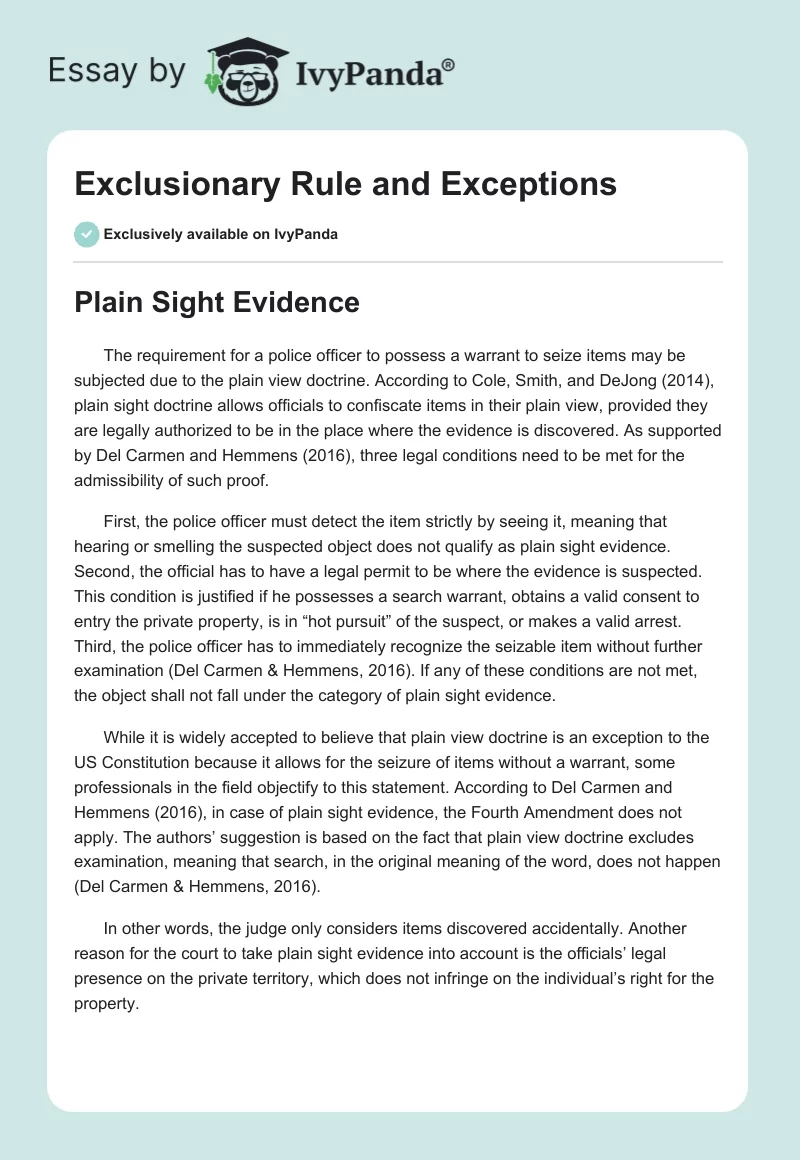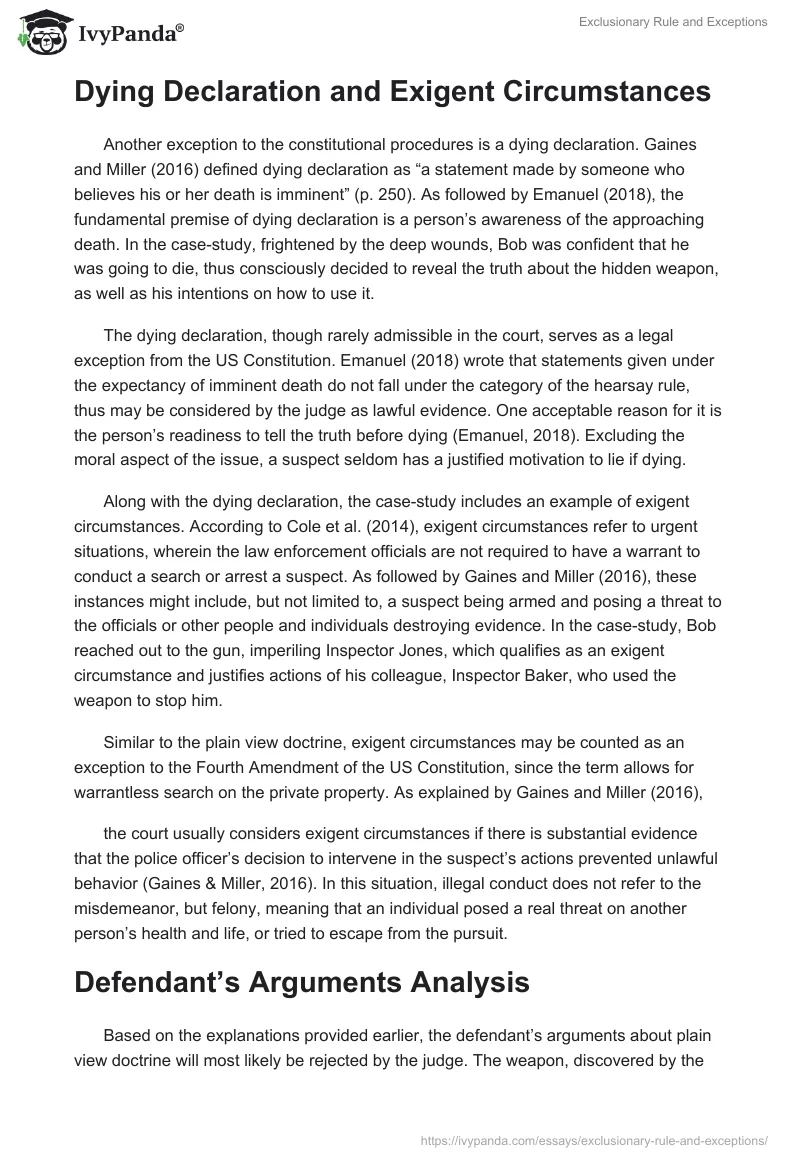Plain Sight Evidence
The requirement for a police officer to possess a warrant to seize items may be subjected due to the plain view doctrine. According to Cole, Smith, and DeJong (2014), plain sight doctrine allows officials to confiscate items in their plain view, provided they are legally authorized to be in the place where the evidence is discovered. As supported by Del Carmen and Hemmens (2016), three legal conditions need to be met for the admissibility of such proof.
First, the police officer must detect the item strictly by seeing it, meaning that hearing or smelling the suspected object does not qualify as plain sight evidence. Second, the official has to have a legal permit to be where the evidence is suspected. This condition is justified if he possesses a search warrant, obtains a valid consent to entry the private property, is in “hot pursuit” of the suspect, or makes a valid arrest. Third, the police officer has to immediately recognize the seizable item without further examination (Del Carmen & Hemmens, 2016). If any of these conditions are not met, the object shall not fall under the category of plain sight evidence.
While it is widely accepted to believe that plain view doctrine is an exception to the US Constitution because it allows for the seizure of items without a warrant, some professionals in the field objectify to this statement. According to Del Carmen and Hemmens (2016), in case of plain sight evidence, the Fourth Amendment does not apply. The authors’ suggestion is based on the fact that plain view doctrine excludes examination, meaning that search, in the original meaning of the word, does not happen (Del Carmen & Hemmens, 2016).
In other words, the judge only considers items discovered accidentally. Another reason for the court to take plain sight evidence into account is the officials’ legal presence on the private territory, which does not infringe on the individual’s right for the property.
Dying Declaration and Exigent Circumstances
Another exception to the constitutional procedures is a dying declaration. Gaines and Miller (2016) defined dying declaration as “a statement made by someone who believes his or her death is imminent” (p. 250). As followed by Emanuel (2018), the fundamental premise of dying declaration is a person’s awareness of the approaching death. In the case-study, frightened by the deep wounds, Bob was confident that he was going to die, thus consciously decided to reveal the truth about the hidden weapon, as well as his intentions on how to use it.
The dying declaration, though rarely admissible in the court, serves as a legal exception from the US Constitution. Emanuel (2018) wrote that statements given under the expectancy of imminent death do not fall under the category of the hearsay rule, thus may be considered by the judge as lawful evidence. One acceptable reason for it is the person’s readiness to tell the truth before dying (Emanuel, 2018). Excluding the moral aspect of the issue, a suspect seldom has a justified motivation to lie if dying.
Along with the dying declaration, the case-study includes an example of exigent circumstances. According to Cole et al. (2014), exigent circumstances refer to urgent situations, wherein the law enforcement officials are not required to have a warrant to conduct a search or arrest a suspect. As followed by Gaines and Miller (2016), these instances might include, but not limited to, a suspect being armed and posing a threat to the officials or other people and individuals destroying evidence. In the case-study, Bob reached out to the gun, imperiling Inspector Jones, which qualifies as an exigent circumstance and justifies actions of his colleague, Inspector Baker, who used the weapon to stop him.
Similar to the plain view doctrine, exigent circumstances may be counted as an exception to the Fourth Amendment of the US Constitution, since the term allows for warrantless search on the private property. As explained by Gaines and Miller (2016),
the court usually considers exigent circumstances if there is substantial evidence that the police officer’s decision to intervene in the suspect’s actions prevented unlawful behavior (Gaines & Miller, 2016). In this situation, illegal conduct does not refer to the misdemeanor, but felony, meaning that an individual posed a real threat on another person’s health and life, or tried to escape from the pursuit.
Defendant’s Arguments Analysis
Based on the explanations provided earlier, the defendant’s arguments about plain view doctrine will most likely be rejected by the judge. The weapon, discovered by the police officers, qualifies as plain sight evidence because the act of locating it satisfies all three legal requirements. Since Bob voluntarily allowed inspectors on his property, agreeing to answer their questions, they had been in his yard legally. Guns, stored in the shed, immediately drew officials’ attention, meaning that no intentional examination happened. Finally, because the door to the barn was open, the weapon was in a plain view of the police officers.
Unlike the plain view doctrine, the dying declaration is more complex to argue against. On the one hand, when Bob saw his wounds, he was sure that he was dying, engaging in a voluntary confession, which satisfies the premise of dying declaration: awareness of the imminent death. On the other hand, however, the actual death did not happen, meaning that the statement cannot be used in the court.
As noted by Emanuel (2018), at common law, if the person who made a dying declaration appeared to be alive, the statements recorded lose their power. While the requirement about actual death of the individual has indeed existed for a long time, recent modifications to the Federal rules (FRE 804(b)(2) removed it from the legal conditions for a dying declaration (Emanuel, 2018). In this case, the defendant’s reasoning will be rejected, since the accused consciously provided information about his unlawful intentions, thinking he was dying.
References
Cole, G. F., Smith, C. E., & DeJong, C. (2014). The American system of criminal justice (14th ed.). Boston, MA: Cengage Learning.
Del Carmen, R.V., & Hemmens, C. (2016). Criminal procedure: Law and practice (10th ed.). Boston, MA: Cengage Learning.
Emanuel, S. L. (2018). Emanuel law outlines for evidence (9th ed.). Alphen aan den Rijn, Netherlands: Wolters Kluwer Law & Business.
Gaines, L. K., & Miller, R. L. (2016). Criminal justice in action: The core. Boston, MA: Cengage Learning.


